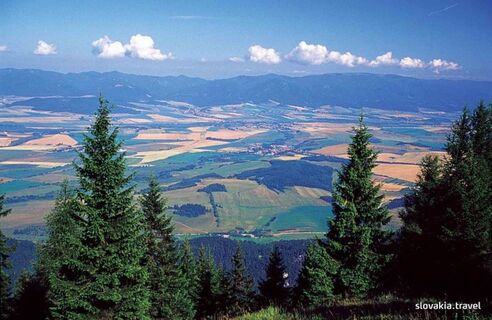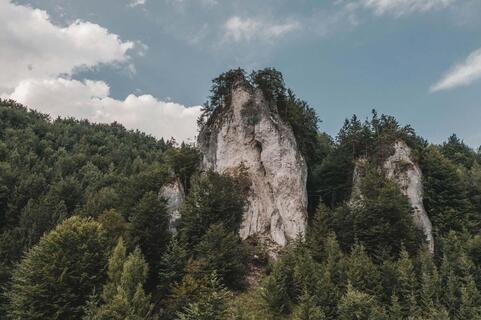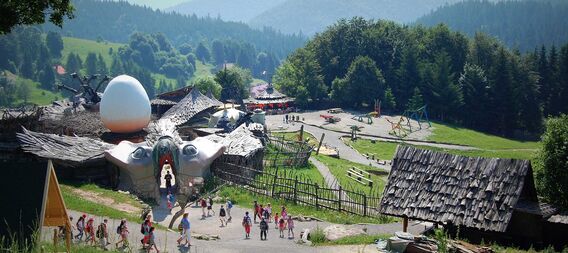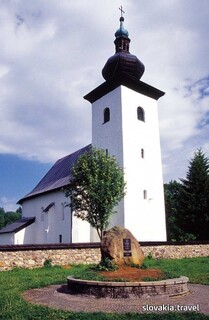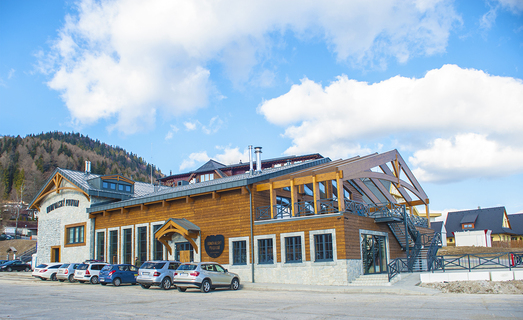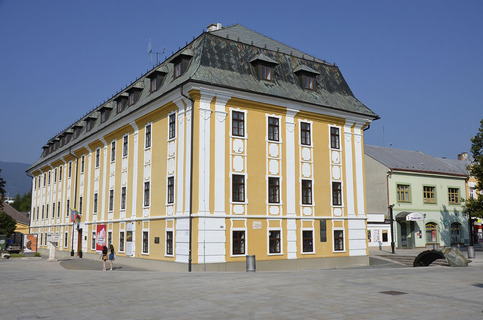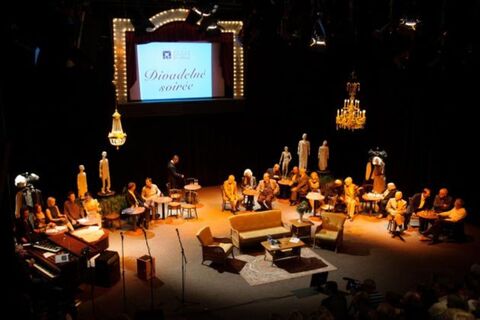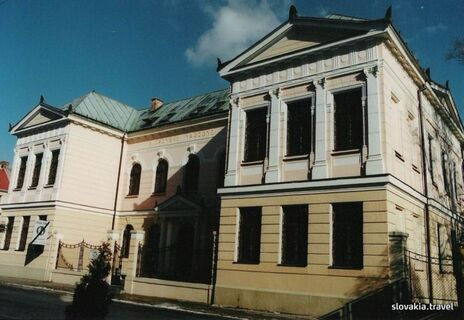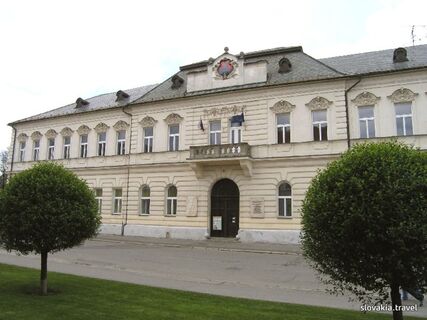Blatnický Castle
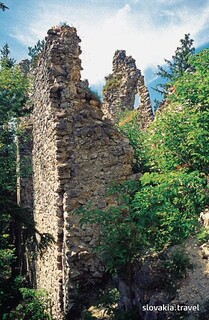
Ruins of the Blatnický hrad Castle stand near the village Blatnica on the low but sharp limestone ridge, which separates Gaderská dolina valley from the Turčianska kotlina basin. It dates to the 13th century.
Situation of the village Blatnica next to the Gaderská dolina and Blatnická dolina valleys makes of it an ideal salient point for the trips to the spectacular valleys of the Veľká Fatra Mts.
Continuation of the Gaderská dolina valley in its upper end is the valley of Dedošová and together they are almost 18 kilometres long. It is in fact a canyon with bulky rocks, rock towers and other interestingly shaped rock formations. Its rich and rare flora and occurrence of rare animals enhance its attractiveness.
The Blatnická dolina valley is somewhat shorter but also interesting. It is often used for the access to the areas of Krížna and Kráľova studňa Mts. in the main ridge of the Veľká Fatra Mts. In the lower part of the valley is the conspicuous rock - Skalné okno (Rock Window).
The marked hiking trail, which passes through the in places deep and canyon-shaped Konský dol and leads to the imposing limestone massif of Tlstá, connects the Gaderská and Blatnická dolina valleys. The ascent to the Tlstá Mt. is rather demanding even for experienced hikers. Beyond the altitude of 700 m there are bulky rock terraces and tall rock faces visible from a long distance. There is also one of the biggest caves of the Veľká Fatra Mts. - the Mažarná cave (not accessible to public).







The National Park of Veľká Fatra, lying in central Slovakia is typical for its continuous forest, long valleys and the largest locality of original yew tree occurrence in Europe.
Čo by ste povedali na prechádzku parkom, kde rastie viac ako 400 druhov stromov z celého sveta? Išli by ste sa prejsť? Ak áno, vyberte sa na návštevu do obecného parku v Turčianskej Štiavničke, ktorý je skutočným arborétom.
The Harmanecká jaskyňa cave is situated in the Veľká Fatra Mts. The cave is known for occurrence of rare white soft sinter, tall pagodas and sinter lakes.
Ferrata Dve veže is located about 4 km from the resort Gothal, in the direction of the neighboring village Liptovské Revúce. You can find it in the area that the locals used to call "Zahorovo". From the highest point of the ferrata you are offered beautiful views of the surrounding hills of the Low Tatras (Končitá, Malý Zvolen, Montenegro), Veľká Fatra (Krížna, Frčkov) and also the National Parks Veľká Fatra and Nízke Tatry, which is separated by the river Revúca.
We invite all those who want to experience the atmosphere of Slovak folk tales to our non-traditional village, which consists of houses in the style of folk-fantasy architecture.
Do you know, what you want to be, when you grow up? Don’t wait until you grow up. Come to Donovalkovo, the capital city of children, and you can become a firefighter, policeman, banker, car racer, doctor and a lot more.
HRADISKO The saddle beneath Vyšehrad was a strategic passage from Ponitria to Turca , already used in the beginnings of the settlement of Slovakia . The traces of settlement can be traced back to the hard-to-reach hill of Vyšehrad from the early Stone Age . Significant traces are associated with the Bronze Age and the people of the Lusatian culture (1200-700 BC) as well as with the later Iron Age (750 BC), from which many finds were found. The most important role was played by the fortification during the period of Great Moravia, when it was the center of the region . The settlement of the territory to the north required the construction of fortified sites, from which the power of Ponitria to Turca, Orava or Liptov was expanded. The defensive and commercial function of the Upper Castle gradually took over the surrounding settlements and after the demise of the Great Moravia its significance dropped. CASTLE VYŠEHRAD In the 13th century , the first written reports of Vyšehrad , which managed the Diviack family, appeared. Since 1277, it is reported that after the Mongol invasion, Vyšehrad was remembered only as a former castle . In the 15th century , part of the brothers, persecuted by the royal troops, resorted to Vyšehrad. From this period, finds of weapons , various iron objects , components of horse harnesses , corners , and especially coins are coming . NPR VYŠEHRAD The territory at the top is part of Vysehrad NPR. Vyšehrad is a national nature reserve since 1973 . A territory with the 4th degree of protection covers the top part of Vyšehrad and a large part of the western foothill with an area of more than 48 hectares. The object of the protection is the Vyšehrad limestone massif with forest vegetation and rare species of insects .
The waterfall is located on Jeleňý potok, a right-hand tributary of Čutkovský potok. It is cascading, two-story and its most beautiful is its upper part. From a professional point of view, this is the so-called destructive waterfall, which means that its height and slope decreases over the ages by the action of water. Jelení waterfall is one of the stops on the educational trail Známa neznáma Čutkovská dolina. The trail starts at the mouth of the Čutkovská valley and opens up all the most interesting corners of the area. The section in front of the waterfall is equipped with 84 steps due to the more demanding terrain. As the amount of water in the waterfall fluctuates during the year, it is best to visit it in the spring or during periods of heavy rain.
In a beautiful place near Kremnické Bane, central Slovakia, a stone is erected next to an ancient church of John Baptist. It reminds the passers-by that it is exactly here that the geographical centre of Europe is situated.
Čierna Ovca sa nachádza na rozhraní Veľkej Fatry a Kremnických vrchov v bezprostrednej blízkosti sviežeho horského potoka. Jedinečnosť tohto prostredia znásobuje prítomnosť Harmaneckej jaskyne, ktorej návšteva začína aj končí, práve u nás. A preto doprajte kulinársky zážitok svojmu telu, v krásnom prostredí Národného parku Veľká Fatra.
Donovalský pivovar sa zrodil v krásnych, no drsných horách stredného Slovenska. Jeho život sa začal našim odvážnym a pritom tak prostým odhodlaním: už od počiatku variť poctivé pivo. Náš unikátny pivovar okrem útulnej reštaurácie ponúka aj čerstvé pekárenské výrobky z vlastnej pekárne a útulnú kaviareň. Milovníkom hôr prinášame osobitú skupinu pív, z ktorej je každé jedno výnimočné.
Koliba u dobrého pastiera je unikátny komplex ubytovacích, stravovacích služieb v lone nádhernej liptovskej prírody iba 5 minút od centra mesta Ružomberok. Celá stavba je z prírodných materiálov a v duchu slovenskej tradície.
Rodinný salaš s 300 ovečkami ,výrobou syrov, 100% bryndzou , pekárňou , reštauráciou a s múzeom hospodárskych strojov . Založený v roku 2001.
Reštaurácia Salaš Kľak sa nachádza vo Fačkovskom sedle s pekným výhľadom na dominantu regiónu - najvyšší vrch Kľak (1351 m n.m.) v príjemnom prostredí okolitej prírody. Kuchyňa je zameraná na ponuku tradičných slovenských jedál.
Featuring free WiFi and a sun terrace, Horský Hotel Kľak offers pet-friendly accommodation in Kľačno. The hotel has ski-to-door access and a ski school, and guests can enjoy a meal at the restaurant. Free private parking is available on site.
Vitajte v srdci Stredného Slovenska, Vitajte v Banskej bystrici, Vitajte v Plzenskej reštaurácii...
Leroy Bar & Café nie je len podnik, kde si môžete dať kvalitnú kávu, ale aj miesto, kde si môžete prísť oddýchnuť od každodenného zhonu. Snažíme sa, aby ste sa u nás cítili príjemne a po každej návšteve sa chceli ku nám znovu vrátiť.
Set in a quiet area in the village of Blatnica, Hotel Gader features rooms with attached bathroom, free WiFi, and an outdoor barbecue area.
Turciansky dvor - Apartmany Turiec is located in peaceful surroundings in Kostany nad Turcom between the Mala Fatra and Velka Fatra national parks and offers you en-suite rooms and an on-site restaurant.
Located in the centre of Martin, Hotel Turiec overlooks the Velka Fatra Mountains. It has a spa with a sauna, provides free on-site parking, and offers spacious rooms with LCD TV.
Koliba u dobrého pastiera je unikátny komplex ubytovacích, stravovacích služieb v lone nádhernej liptovskej prírody iba 5 minút od centra mesta Ružomberok. Celá stavba je z prírodných materiálov a v duchu slovenskej tradície.
Featuring free WiFi and a sun terrace, Horský Hotel Kľak offers pet-friendly accommodation in Kľačno. The hotel has ski-to-door access and a ski school, and guests can enjoy a meal at the restaurant. Free private parking is available on site.
Termálne kúpalisko Vieska ponúka 50x25 metrový plavecký bazén, detský bazén a tobogány. Súčasťou areálu kúpaliska je mutlifunkčné ihrisko, lezecká stena, minigolf, futbal, tenis, petanque, volejbal, basketbal a nohejbal. Teplota vody dosahuje 26 - 27 °C.
The centre of the southern part of Turiec is the spa Turčianske Teplice. The local hot springs were first mentioned in the 13th century. The legend has that King Sigismund of Luxembourg bathed in local springs in 1423. The town of Kremnica acquired the land with springs in 1532 and invested in construction of the first spa buildings. The spa was especially popular and visited in time of wars with the Habsburgs when the noble rebels used it as a refuge.
The Spa & Aquapark resort is in a beautiful aqua park, in the centre of Turčianske Teplice. It has two parts: ‘SPA‘ area (healing thermal water, 38 °C) and AQUAPARK area (thermal water up to 33 °C). Both are open throughout the year.
Ferrata Dve veže is located about 4 km from the resort Gothal, in the direction of the neighboring village Liptovské Revúce. You can find it in the area that the locals used to call "Zahorovo". From the highest point of the ferrata you are offered beautiful views of the surrounding hills of the Low Tatras (Končitá, Malý Zvolen, Montenegro), Veľká Fatra (Krížna, Frčkov) and also the National Parks Veľká Fatra and Nízke Tatry, which is separated by the river Revúca.
Bungee trampolines are without doubt one of the most demanded attractions of amusement parks of recent years. They are a combination of an aluminium constructions, latex rubber and a very springy trampoline, all thought up by VIV Slovakia, s.r.o. Everything is driven by precisely tuned motors. There are 4 independent trampolines on each of which the jumper, secured in a special harness fastened to the X-jump part of the trampoline, can achieve heights of up to 7m and also forward and backwards moves thanks to the rubber which also maintain the balance of the jumper.
Discover Donovaly quickly, ecologically and comfortably from the seat of a modern e-scooter and enjoy a lot of fun on two wheels.
TRY AN UNBELIEVABLE TANDEM FLIGHT OVER DONOVALY!
The rope centre is located in the forest bordering the main E77 road from Banská Bystrica and Ružomberok and with a length of more than 500m is one of the longest and largest rope centres in the whole of Slovakia.
The Donovaly Fun Arena adrenaline centre is expanding during the summer of 2017 with a unique novelty for Slovakia - a children's aqua experience-educational park with 9 attractions, which follow one another and form one whole experience.
Over the months April to July 2008 the second toboggan run of its kind in Slovakia from the renowned German company Wiegand took shape in the vicinity of the TELEMIX Nová hoľa cablecar station and the Husky aprés ski bar.
Ruins of the Blatnický hrad Castle stand near the village Blatnica on the low but sharp limestone ridge, which separates Gaderská dolina valley from the Turčianska kotlina basin. It dates to the 13th century.
The Museum of the Slovak Village is the largest ethnographic open-air exposition in Slovakia. The museum, located in Jahodnícke háje in the southeastern part of the town of Martin, has been built by the Slovak National Museum in Martin since the 1960s. It provides a picture of traditional folk architecture, housing and the way of life of people who lived in northwestern Slovakia in the latter half of the 19th century and the first half of the 20th century.
The Castle of Sklabiňa towers on the edge of the basin Turčianska kotlina and the mountains Veľká Fatra. It was first mentioned in 1242. After 1320, the Sklabiňa Castle became the seat of the county administration of Turiec.
In 1933, the museum opened its second building to the public. After its merger with the Bratislava-based Slovak National Museum in 1961, the museum began to be distinguished as Slovakia-wide Ethnography Museum that specializes in the preservation, research, documentation and presentation of folk material and spiritual culture in Slovakia.
A permanent exposition called Slovak Modern 20th-Century Art in Turiec presents the works of well-known personalities associated with the Turiec region (M. A. Bazovský, J. Alexy, M. Benka, Ľ. Fulla) and a selection of works of artists included in Mikuláš Galanda's Group. Part of the exposition is devoted to Galanda and his works from the areas of painting, graphics and applied arts. Regularly-held exhibitions showcase mainly works of contemporary Slovak as well as foreign artists.
Slovenské komorné divadlo v Martine vzniklo roku 1944 ako druhé profesionálne divadlo na Slovensku. V divadelnom Martine sa už po vzniku ČSR začalo uvažovať o založení profesionálneho divadla.
SNM - Múzeum Andreja Kmeťa je od svojich počiatkov regionálne vlastivedné múzeum a sídli v prvej budove SNM z roku 1908.
The Slovak National Literary Museum of the Slovak National Library, as the country's central literary museum, fulfills museum, documentation and presentation mission. It collects, administers, preserves and provides access to museum objects that are related to the history of Slovak literature.
The exposition presents authentic environment and visual works of art of prominent, versatile artist, but mainly painter nad illustrator - national artist Martin Benka. In line with Benka's last will, the interior of the museum (Benka's workroom, studio and bedroom) is preserved in its authentic form.
High above the village Kláštor pod Znievom in the Malá Fatra Mts. raise the ruins of the Zniev Castle. It is the second highest situated castle in Slovakia (985 m).
HRADISKO The saddle beneath Vyšehrad was a strategic passage from Ponitria to Turca , already used in the beginnings of the settlement of Slovakia . The traces of settlement can be traced back to the hard-to-reach hill of Vyšehrad from the early Stone Age . Significant traces are associated with the Bronze Age and the people of the Lusatian culture (1200-700 BC) as well as with the later Iron Age (750 BC), from which many finds were found. The most important role was played by the fortification during the period of Great Moravia, when it was the center of the region . The settlement of the territory to the north required the construction of fortified sites, from which the power of Ponitria to Turca, Orava or Liptov was expanded. The defensive and commercial function of the Upper Castle gradually took over the surrounding settlements and after the demise of the Great Moravia its significance dropped. CASTLE VYŠEHRAD In the 13th century , the first written reports of Vyšehrad , which managed the Diviack family, appeared. Since 1277, it is reported that after the Mongol invasion, Vyšehrad was remembered only as a former castle . In the 15th century , part of the brothers, persecuted by the royal troops, resorted to Vyšehrad. From this period, finds of weapons , various iron objects , components of horse harnesses , corners , and especially coins are coming . NPR VYŠEHRAD The territory at the top is part of Vysehrad NPR. Vyšehrad is a national nature reserve since 1973 . A territory with the 4th degree of protection covers the top part of Vyšehrad and a large part of the western foothill with an area of more than 48 hectares. The object of the protection is the Vyšehrad limestone massif with forest vegetation and rare species of insects .
